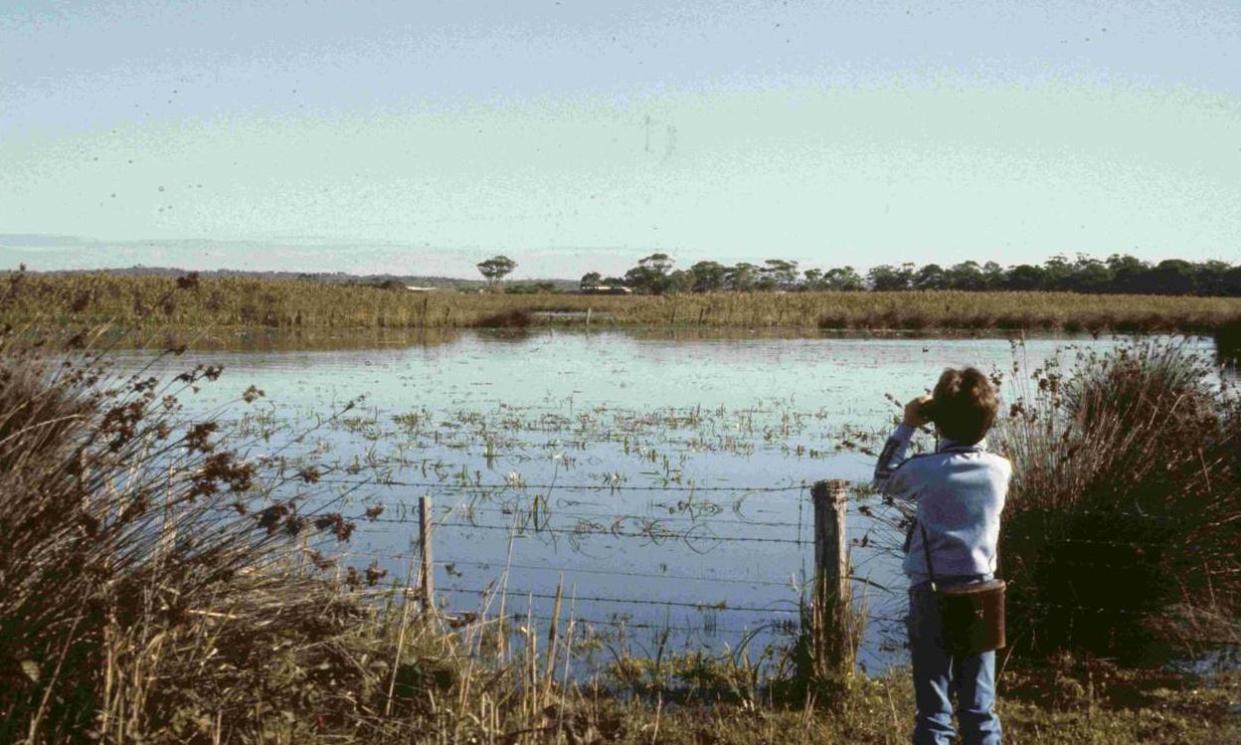‘Not the only birder in the village’: how citizen science is the bedrock of tackling species loss

Sean Dooley first started birdwatching as a 10-year-old with a notebook in hand at a place then known as the “Seaford swamp”, a freshwater wetland beside his primary school in Melbourne’s south-east.
“I was just going out as a kid doing what I loved but recording the birds I saw as I did,” he says. On one of his early visits he met another birdwatcher, Mike Carter, who had been recording birds there and also at nearby Edithvale swamp for some years.
The pair began reporting the bird sightings into regular national shorebird and waterbird counts and then later into the Birdata database.
What had started out as a hobby for Dooley soon began reaping real world outcomes. “These counts were ultimately used in the bid to recognise these swamps as wetlands of international significance under the Ramsar Convention,” he says.
In 2001, the Edithvale-Seaford wetlands became the only fully urban Ramsar-listed wetland in Australia. That was only achieved because of the monitoring data they and other avid birders had collected demonstrating how the wetlands are vital habitat for migratory shorebirds and waterbirds, such as the nationally endangered Australasian bittern.
“The listing is vitally important for the protection of the wetlands and they are now managed for those values by the land managers,” Dooley says. “It wouldn’t have happened without citizen science.”
Protecting threatened species
It’s not just diminishing bird populations that can benefit from having active volunteers out in remote wild places tracking their movements or reporting illegal land clearing.
In 2020 the Australian Conservation Foundation (ACF) along with other groups nominated the platypus to be protected under Australia’s national threatened species laws, however the nomination was rejected as it was determined there was insufficient data to list the species.
Designed with researchers from the University of New South Wales, ACF’s Platy-project enables anyone to record platypus sightings around Australia via an online map, in an effort to plug holes in the data around platypus numbers nationally.
“We have run the project for two years and had really promising results, including finding platypus in new locations where they had previously been considered locally extinct,” says Peta Bulling, an ACF nature campaigner.
Related: ‘Planting a tree is hope in action’: the people regenerating urban habitats and growing community
Bulling says that on top of the practical benefits of the project in identifying and ultimately protecting the remaining native platypuses in Australia, citizen science projects such as these are also immensely beneficial in terms of allowing participants to feel more connected to nature.
“[It] helps to raise awareness of the threats facing the plants and animals we love.”
Using a phone or smart device
While actual nature immersion is the ideal, even for those unable to escape urban jungles it is still possible to make a meaningful contribution.
Kim Garratt, an environmental investigator at ACF, says she had seen enough evidence from overseas crowd-sourced investigations to know how impactful they could be here.
“I was inspired by some clever crowd-sourced investigations I’d seen developed by international researchers and NGOs, which enabled interested folks with just a little bit of time and an internet connection to contribute to really important studies,” she says.
ACF trialled its first crowdsourced investigation in 2023 that saw over 2000 volunteers sign up to examine satellite pictures and check for significant changes to vegetation cover. These volunteers scanned more than 3,681,000 hectares of at-risk native habitat.
While a lot of Australian deforestation goes unreported, thanks to the data gleaned from volunteers on their smart devices, ACF was able to spot dozens of individual cases of important habitat that had been illegally bulldozed.
From there it would undertake an analysis of threatened species records, satellite imagery, vegetation mapping and consult the register of Environment Protection and Biodiversity Conservation approvals – before contacting the landholder.
Related: A birder’s calendar: where and when to watch Australia’s breeding and migration seasons
“Because we were able to cover so much ground so quickly, in some cases the bulldozing was still happening and we were able to actually stop it in its tracks,” says Garratt, citing one example where the team uncovered an area of 250 hectares of regent honeyeater habitat outside Armidale in NSW that had been bulldozed.
Reversing the climate and extinction crisis
After gravitating to birdwatching as a youngster, Dooley now works for BirdLife Australia, which runs the Aussie Bird Count that has swelled in popularity to involve over 60 thousand volunteers reporting bird counts wherever they happen to be around the country – either in the bush, their own back yard, or even out the office window.
“It’s nice to know you’re not the only birder in the village,” he says. At a time when Australian birds and animal species are facing an unprecedented extinction crisis, Dooley says it is impossible to effectively mobilise efforts to save them without knowing what is really going on.
“Citizen science monitoring, especially when it’s done systematically and repeated at the same location over time, provides the bedrock of how we tackle this crisis.”
Garratt from ACF agrees, noting that there are so many people out there, especially Gen-Z’ers, looking for an easy way to make a real difference using technology.
“The great thing about citizen science is that other people are taking care of the research design, site selection, data validation etc, so all you have to do is show up and do a simple task and then you know that your efforts are going to count for something,” she says.


